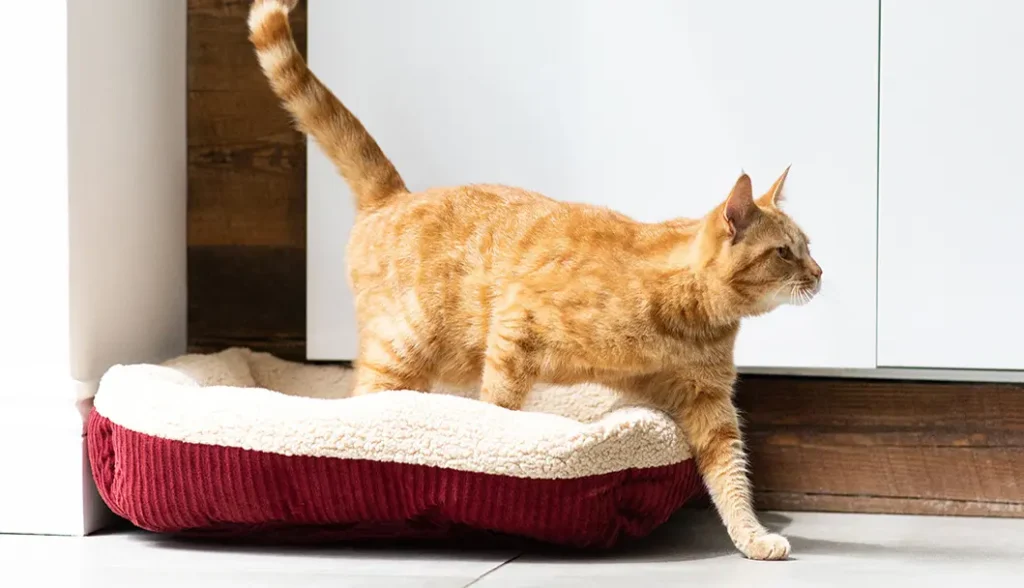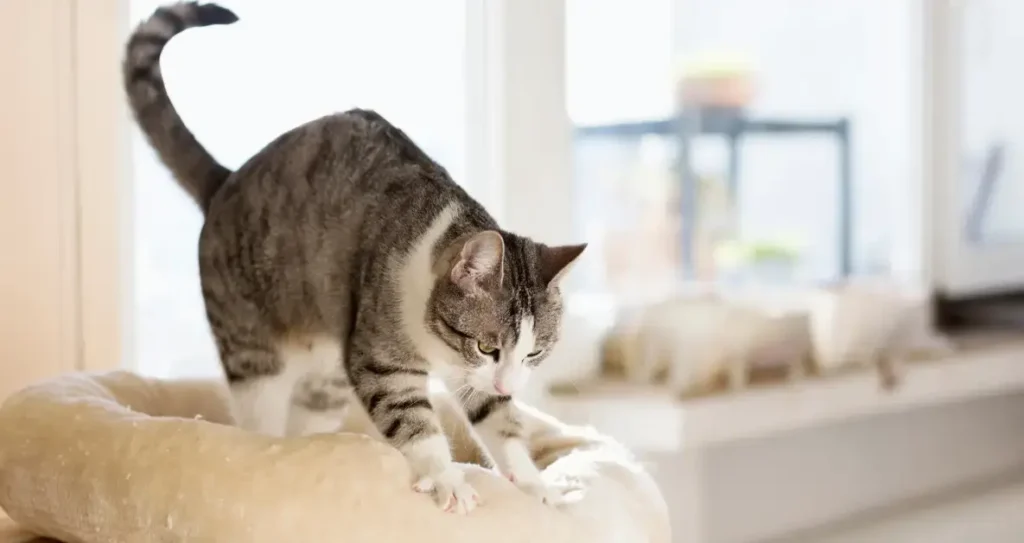How Do Cats Communicate Through Tail Movements?

I. Introduction
Cats have their special language, and their tails are like little flags waving messages to other cats and even to us. Understanding how cats talk through their tails helps us connect better with them. So, let’s delve into how cats use tail movements to communicate.
A. Brief overview of cat communication
Cats are known for their mysterious ways, and a big part of that is how they talk to each other and to humans. They use different body parts like their eyes, ears, and, importantly, their tails to express themselves.
B. Importance of understanding cat behavior and communication
Understanding cat behavior isn’t just for fun—it helps us take better care of them. When we know what a cat is feeling or trying to say, we can make sure they’re happy and comfortable.
C. Thesis statement: Tail movements as a significant form of feline communication
One of the most important ways cats communicate is through their tails. Every twitch, flick, or wag can carry a message, whether it’s “I’m happy,” “Stay away,” or “Let’s play!” Deciphering these signals enhances our understanding of our feline friends.

II. Anatomy of a Cat’s Tail
Understanding how cats use their tails to communicate starts with knowing what their tails are made of, what they do for the cat’s body, and why they communicate this way.
A. Description of a cat’s tail structure
A cat’s tail consists of bones, muscles, and nerves. It’s like a flexible rod attached to their body that they can move in different ways. The tail is covered in fur, just like the rest of the body.
B. Functions of the tail in feline physiology
The tail isn’t just for show—it’s quite useful! Cats use their tails for balance, especially when they’re climbing or jumping. It also helps them to communicate with other cats and even with us humans.
C. Evolutionary significance of tail communication
Over thousands of years, cats have evolved to use their tails to communicate because it helps them survive. Cats are hunters by nature, and being able to signal to each other without making noise can be handy when they’re stalking prey or avoiding danger. So, tail communication is not just a quirk—it’s a crucial part of being a cat!

III. Types of Tail Movements
Cats have a whole repertoire of tail movements, each with its special meaning. Let’s explore the different types and what they say.
A. Overview of the different types of tail movements
- Vertical movements: Cats often move their tails up and down. This can mean they’re feeling friendly and confident.
- Horizontal movements: Sometimes, cats wag their tails side to side. This can show excitement or agitation.
- Puffed tail: When a cat’s tail gets all big and fluffy, it usually means they’re scared or trying to look bigger to intimidate something scary.
- Twitching tail: A twitching tail might mean a cat is focused or irritated. It’s like their way of saying, “I’m busy, leave me alone!”
B. Explanation of each type with accompanying behaviors and meanings
- Vertical movements: When a cat greets you with a raised tail, it’s like a friendly handshake. They’re saying, “Hey there, I’m happy to see you!”
- Horizontal movements: If a cat’s tail is swishing from side to side, they might be feeling playful or annoyed. It’s a good idea to pay attention to their body language to figure out which one it is.
- Puffed tail: If you see a cat with a puffed-up tail, it’s best to give them some space. They’re probably feeling threatened or scared and might lash out if you get too close.
- Twitching tail: When a cat’s tail is twitching, it means they’re focused on something. Maybe they’re watching a bug or getting ready to pounce on a toy. It’s best to let them do their thing until they’re done.
IV. Interpreting Tail Movements
Understanding what a cat’s tail is saying isn’t always straightforward. Let’s look at how we can decode their messages and what factors can influence their tail movements.
A. Understanding the context of tail movements
To understand what a cat’s tail is saying, we need to pay attention to what’s happening around them. Their tail movements can mean different things depending on the situation they’re in.
B. Factors influencing tail movements
- Emotional state: Just like humans, cats’ tails can give away their emotions. If they’re feeling happy, scared, or angry, their tail will reflect that.
- Social interactions: When cats interact with other cats or even with us humans, their tails can show how they’re feeling about the interaction. It’s like their way of communicating without words.
- Environmental stimuli: Sometimes, things in the environment can affect a cat’s tail movements. Loud noises, sudden movements, or unfamiliar smells can all make a cat’s tail twitch or puff up.
C. Common misinterpretations of tail movements
- Misinterpreting playfulness: Sometimes, a cat’s playful tail movements might be mistaken for aggression. It’s important to pay attention to their other body language cues to understand their true intentions.
- Ignoring fear signals: If a cat’s tail is puffed up or tucked between their legs, it means they’re scared or anxious. Ignoring these signals can lead to misunderstandings and even stress for the cat.
- Assuming all tail movements are friendly: While a raised tail might seem like a friendly greeting, it can also indicate excitement or even irritation. It’s essential to consider the context and the cat’s overall body language to interpret their tail movements accurately.
V. Tail Communication in Various Scenarios
Cats use their tails to speak in different situations, whether they’re playing, feeling threatened, looking for love, or interacting with us humans. Let’s explore how they use tail language in various scenarios.
A. Tail communication during play
When cats are having fun, their tails often reflect their excitement. A cat chasing a toy might have a twitching tail, showing how eager they are to catch it. Tails held high or wagging gently can indicate playful intentions, inviting others to join in the fun.
B. Tail signals in aggressive encounters
When cats get into a spat, their tails can reveal a lot about their intentions. A puffed-up tail signals that a cat is ready to defend themselves, while a low, swishing tail might indicate agitation or aggression. It’s like a warning sign to back off!
C. Tail language during mating rituals
During mating season, cats use their tails to communicate their readiness to mate. A female cat in heat might raise her tail and move it to the side to signal to male cats that she’s ready to reproduce. Male cats might also use their tails to show interest or dominance in pursuing a mate.
D. Tail movements in communication with humans
Cats don’t just talk to other cats with their tails—they also use them to communicate with us humans. A gently swishing tail might indicate contentment, while a rapidly flicking tail could mean they’re feeling agitated or overstimulated. Learning to read these signals helps us understand our furry friends better and strengthen our bond with them.
VI. Cultural and Individual Variations
Just like humans, cats’ tail language can vary depending on where they live and their unique personalities. Let’s explore how cultural differences and individual quirks play a role in tail communication.
A. Cultural differences in interpreting cat tail movements
Different cultures may have their interpretations of cat tail movements. In some places, a raised tail might be seen as a sign of friendliness, while in others, it could be seen as a warning. Understanding these cultural differences can help us communicate better with cats from different backgrounds.
B. Individual variations in tail communication among cats
Just like people, each cat has its personality and way of communicating. Some cats might have more expressive tails than others, while some might use their tails less to communicate. Paying attention to individual quirks helps us understand each cat’s unique language.
C. Importance of context in understanding tail signals
Context is key when it comes to interpreting cat tail movements. A raised tail might mean one thing during playtime but something completely different during a tense encounter. Taking into account the situation, the cat’s body language, and the environment helps us decipher their true intentions.
VII. Practical Implications and Applications
Understanding how cats use their tails to talk isn’t just interesting—it can also be really helpful for cat owners, veterinarians, and scientists studying animal behavior. Let’s explore some practical ways this knowledge can be applied.
A. Importance for cat owners and caretakers
For cat owners and caretakers, knowing how to interpret their cat’s tail movements can make a big difference in their relationship. It helps them understand when their cat is happy, scared, or in need of space. This understanding can lead to better care and a deeper bond between humans and felines.
B. Enhancing human-cat communication
By learning to read the cat tail language, humans can communicate more effectively with their furry friends. This can lead to fewer misunderstandings and a stronger connection. For example, if a cat’s tail is twitching rapidly, it might be a sign that they’re feeling overwhelmed and need some quiet time alone.
C. Potential applications in veterinary medicine and animal behavior studies
Veterinarians and animal behaviorists can also benefit from understanding cat tail movements. By observing a cat’s tail language, they can assess their emotional state and overall well-being more accurately. This can be especially useful in diagnosing stress-related issues or behavioral problems in cats.
VIII. Conclusion
A. Recap of the significance of tail movements in cat communication
Understanding cat tail movements is like learning a secret language that cats use to talk to each other and us. It’s a crucial part of understanding their feelings and needs.
B. Urging for additional research and comprehension
There’s still so much we can learn about cat tail language. Researchers can delve deeper into how different tail movements correspond to specific emotions or situations, helping us become even better cat whisperers.
C. Closing thoughts on the importance of respecting and understanding feline communication cues
Respecting and understanding cat communication cues, including tail movements, is essential for building strong and loving relationships with our feline companions. By paying attention to their tails, we show them that we care about their feelings and want to communicate with them in a way that they understand.
People also ask
How do cats communicate with their tails?
Cats use their tails to express emotions and intentions to other cats and humans.
What does a cat’s tail movement tell you?
It can indicate if they’re happy, scared, or irritated, depending on the movement.
Do cats control their tail wagging?
Yes, cats have some control over their tail movements, but they can also be involuntary.
How to tell if a cat is happy by its tail?
A relaxed, gently swaying tail often indicates a happy cat.
Why does my cat move his tail when I talk to him?
Your cat may be expressing interest or trying to communicate with you.
What causes cats to thump their tails while lying down?
Thumping tails while lying down could indicate irritation or excitement.



